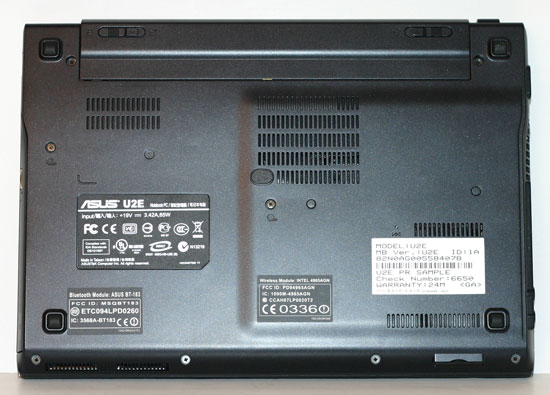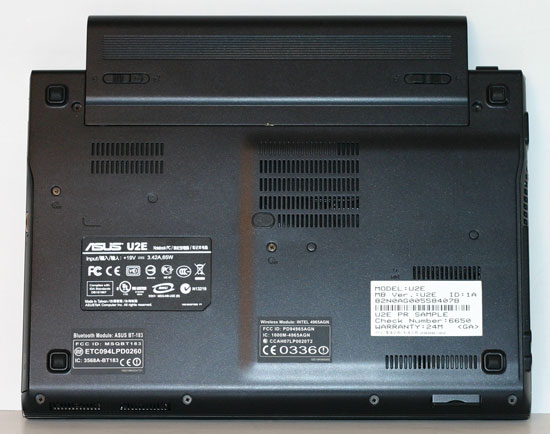Day to Day Use
Back in January, most of the AnandTech editors had a unique opportunity to get up close and personal with the predecessor of the ASUS U2E, the U1E. To help us out with the coverage of CES 2008, ASUS loaned us four U1E laptops. The idea was that we would be able to run around the show floor, take pictures, and then using a mobile broadband service we would upload images and text from the show floor. It all sounded great on paper, but unfortunately we ran into a major difficulty. Thankfully, the problem had nothing to do with the laptops; rather, it was the mobile broadband service. Try as we might, we simply could not get the five Verizon mobile broadband cards to function properly.
That didn't mean that we scrapped the idea of using the U1E laptops, of course. For CES week, plus some time before and after CES, we had a chance to put the U1E through its paces. Opinions varied somewhat, but at least for purposes of running around Las Vegas, visiting with our industry contacts, and wandering the floor of the Las Vegas Convention Center our appreciation for the ultraportable market - and the U1E in particular - was very good. We were able to leave the hotel room in the morning with a full battery charge, work throughout the day (with periods where the laptop was in hibernation mode), and return to our rooms, frequently with more than a third of the battery capacity remaining.
A couple of our major complaints about the U1E have been addressed with the U2E. The first complaint was the lack of an optical drive, which the U2E corrects. The second major issue we had with the U1E was the performance in certain tasks. Specifically, installing applications - especially larger application suites - was at times painfully slow. The additional 1GB of memory helps (the U1E had 1.5GB of memory), and a solid-state drive on the A2B model greatly improves application load times and general hard drive performance. Whether that's enough to counterbalance the reduced hard drive capacity and increased cost is a different matter.
 |
 |
While the U1E and U2E might look very similar at first glance, several of the modifications do make a difference. First, the inclusion of an optical drive ends up making the U2E slightly thicker and heavier than the U1E. The other difference that we noticed almost immediately was in the battery sizes, although here we have to put in a disclaimer that we received the 6-cell 4800 mAh battery with the U1E whereas we received the 3-cell and 9-cell batteries with the U2E. We also didn't have both laptops simultaneously, but our recollection is that the 6-cell battery didn't protrude from the back of the laptop nearly as much as the 9-cell battery does. Since the laptops use the same battery style, however, that shouldn't make too much of a difference.
The default 3-cell battery is all about reducing size and weight. With the battery, the laptop weighs 3 pounds, but battery life is rather poor (just under two hours during light use) despite the ultra mobile components. The flip side is that the 9-cell battery offers terrific battery life but at the cost of the heavier laptop (around 3.5 pounds) and a potentially inconvenient protrusion on the rear of the laptop. If you want a very light and easily transportable laptop, the U2E with the default 3-cell battery will suffice. On the other hand, if you want a laptop that you can unplug and use for an entire day, grab the large 9-cell battery.
I tend to fall into the category of user that appreciates long battery life on an ultraportable, so I'm more inclined to recommend the 9-cell battery. That being the case, I'd almost prefer a slightly larger chassis that would better accommodate the added battery length… say, something like a 13.3" MacBook Air chassis might sound nice. However, I'm not specifically saying I would prefer the MacBook Air as there are other concerns there - like the lack of an integrated optical drive and the non-removable battery.
The other major sticking point is the hard drive, and it's difficult to decide which is more important: performance or capacity. The cost of the 32GB SSD is prohibitively expensive, but the performance of most 1.8" conventional HDDs leaves much to be desired. The core set of applications I use on a computer is relatively small: besides the operating system, all I really need is Microsoft Office and Photoshop. Images fill up hard drive space quickly, as do games, movies, and audio files, but I don't actually need to have all of those on a laptop I'm using for work. If I were to archive data onto a separate system - or an external hard drive - I could easily live with the 32GB solid-state drive. That's likely similar to how most business PC users function, and provided you're willing to pack along a USB hard drive on longer trips and you don't need to work with large data files (i.e. movie editing), the extra money for the SSD might be worthwhile. Still, it's amazing how quickly you can fill up 32GB; regular monitoring of your hard drive usage will definitely be required.
Overall, I enjoyed using the U2E laptop as a secondary computer. It would never be my first computer to use around the house or office, but the U2E is a great laptop to take on business trips or to meetings. You can definitely tell it's substantially slower than a modern desktop system - especially the quad-core overclocked monster I use on a daily basis - but when you focus on typical office tasks the reality is that few people need anything faster than a system that was state-of-the-art four or five years ago. A 1GHz Core 2 Duo is one third as fast in the CPU department as today's midrange desktops - perhaps not even that - but given sufficient memory it can still run Microsoft Office, surf the Internet, send email, and even handle moderate multimedia tasks without difficulty. Just don't even think about firing up the latest 3D games on this type of system.










32 Comments
View All Comments
strikeback03 - Wednesday, April 16, 2008 - link
The Air could easily handle more ports if the edges were squared off instead of curved. An optical drive might still be out of the question, but at least you would have more than one USB port.myr415 - Tuesday, April 19, 2011 - link
Hello,Article very interesting and essential to change the hard drive ...
Cordially
Bonjour,
Article très intéressant et indispensable pour changer le disque dur...
Cordialement
jpl